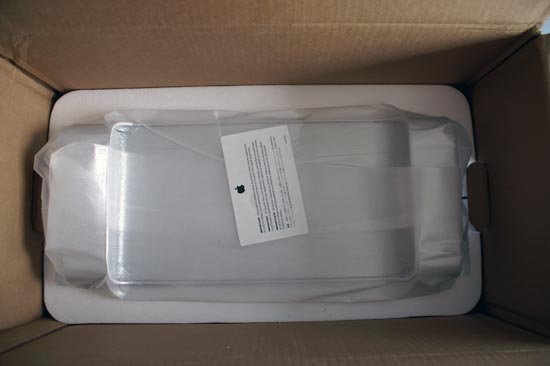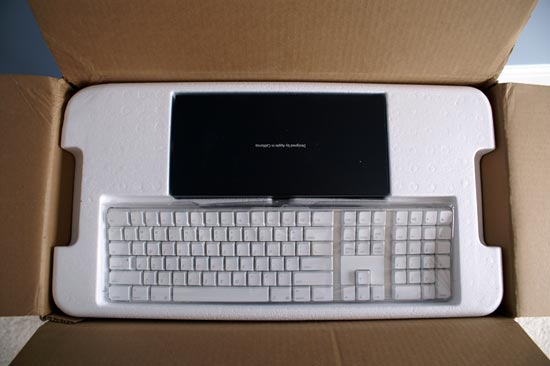Apple's Mac Pro - A True PowerMac Successor
by Anand Lal Shimpi on August 16, 2006 12:27 PM EST- Posted in
- Mac
It's here, it's quiet and it's fast; we got our Mac Pro on Friday and spent every day since taking it apart, using it and benchmarking it. There's far too much to include in one review, so we're breaking it up into three parts. We've already published the first part of our coverage last week, where we discussed the specifications of the new system as well as inadvertently turned the article into a primer on the implications of the FB-DIMMs that the Mac Pro uses. So if you want a brief two-page technical overview of FB-DIMMs, you'll want to consult that article.
Part two is what you're reading today; here we're going to be looking at the Mac Pro as a Mac (mostly) and compare the performance of two speed grades (2.0GHz and 2.66GHz) to the outgoing PowerMac G5. We'll also take the thing apart and give you a nice tour in pictures of the new chassis.

PowerMac G5 (left), Mac Pro box (guess where)
The third and final part will have two focuses - DIY upgrades (e.g. swapping CPUs and sticking in your own FB-DIMMs) as well as performance under Windows XP. Apple just released an updated version of Boot Camp with support for the Mac Pro that should hopefully address some of the serious performance issues we ran into while running Windows XP on our machine. Give us a week and you'll have part 3 to peruse at your leisure.
With our plan of attack laid out, it's time to dive into the Mac Pro and we'll start where very few Mac users like to: at its price. In the past we've generally shied away from getting too caught up in the price debate, because honestly if you're buying a Mac, you're doing so because of the OS and assigning value to that is difficult. Some users are content with other OSes and see no value in OS X, and to them the value in a Mac is simply the total cost of the components that make up the machine. At the same time there are other users who prefer OS X and thus find additional value in a system that is able to run that OS. Regardless of which camp you fall into, the Mac Pro is competitively priced. We'll let the table below do the talking:
|
Apple Mac Pro |
Dell Precision Workstation 490 |
Home Built Config |
|
|
CPU |
2 x Xeon 5150 (2.66GHz) |
2 x Xeon 5150 (2.66GHz) |
|
|
Memory |
2x 512MB DDR2-667 FB-DIMMs |
2x 512MB DDR2-667 FB-DIMMs |
|
|
Graphics |
GeForce 7300 GT |
Quadro NVS 285 |
|
|
Hard Drive |
250GB SATA 3Gbps |
250GB SATA 3Gbps |
|
|
Optical |
SuperDrive (DVD+R DL/DVD+-RW/CD-RW) |
16X DVD+-RW |
|
|
Notes |
Free 17" LCD, had to add sound card, mouse and 1394a card |
Includes Supermicro X7DAE motherboard priced at $474; does not include price of OS, case or power supply |
|
|
Price |
$2499 ($2299 with educational discount) |
$3110 |
$2390 |
The Dell is clearly more expensive, although you can knock off $100 - $200 thanks to the bundled LCD (unfortunately Dell gives you $0 credit if you remove the monitor from your order). We're able to come close with our own configuration by shopping at Newegg and other vendors through our shopping partner, but note that the $2390 total does not include an OS, case or power supply.

If you're in the market for a dual socket dual core Xeon workstation, Apple's Mac Pro is definitely a bargain. The only real issue here is that not everyone needs or can adequately use a dual socket Xeon workstation, in which case you can argue that there's better value in a cheaper single socket Core 2 system. Unfortunately Apple does not offer any such system, which leads us to believe that we'll either eventually see the introduction of a cheaper single socket Mac Pro or maybe even a new product line simply called the "Mac" that uses desktop Core 2 processors instead of their Xeon counterparts.
Bottom line? The default configuration of the Mac Pro is priced very competitively for what you get; whether or not you need what you get is a different discussion entirely.












96 Comments
View All Comments
rockinphotog - Saturday, August 19, 2006 - link
AS a matter of fact, I often use my apple keyboard for my digital camera, printer, syncing my treo and even my wacom tablet.aaronlyon - Friday, August 18, 2006 - link
In next week's article, please evaluate Parallels Workstation for running Windows apps simultaneously with Mac OS. If this works smoothly, why not use Windows versions of Adobe Photoshop and Illustrator? That would be a good solution while waiting for Universal Binary updates.Zebo - Friday, August 18, 2006 - link
Great pics and article Anand.What a deal for such a clean system. They don't build PCs that pretty and this is the best yet from Apple's industrial design squad. I definity want one but don't need four cores.
Can I run Windows fully with this machine? Or maybe I should wait until a single processor (dual core) version comes. If Apple sells $1500 Conroe boxes and it ran windows they counld'nt keep them in stock.
plinden - Friday, August 18, 2006 - link
There's an issue with the speed of SATA hard drives, as Anand mentions here: http://www.anandtech.com/weblog/default.aspx#287">http://www.anandtech.com/weblog/default.aspx#287
It will probably be fixed eventually but if you're relying on this to run Windows, you should wait.
FutureMedia - Thursday, August 17, 2006 - link
You are not comparing the Quad G5 Rear Ports to the Mac Pro Rear Ports. Quad G5 has 3 USB 2 ports as well as 2 Gigabyte Ethernet ports just like the Mac Pro. IE the Quad G5 rear set of ports is IDENTICAL to the Mac Pro rear set - just laid out differently. Only the front adds a fifth USB 2 and second FW800 port not on the Quad G5 which is the same layout as what you show from OLDER not last generation October 2005 PowerMac G5s.Moreover I was looking forward to a Quad G5 comparison with the 2GHz and 2.66 GHz Mac Pros. That is what I want to know. Especially Is even the 2GHz Mac Pro faster than the Quad G5? Is the problem that you don't have a Quad G5 in house to compare it to? I am so bummed out that you didn't compare Mac Pro two bottom speeds with the Quad G5. Please can you do it after next week? I would really appreciate it. Thanks.
PhilG5 - Friday, August 18, 2006 - link
Thank you so much for pointing that out! In fact, Anandtech uses mid-2004 PowerMac G5 (still using AGP graphics and DDR-400 memory!) and doesn't take into account the whole "late 2005" series (which first supported DDR2, PCI-E and had the "Antares" PPC970 core). If you look at Barefeats benchmark results ( http://barefeats.com/quad06.html">http://barefeats.com/quad06.html ) the Quad G5 still seems to be pretty much competitive with the new Mac Pros.Anand Lal Shimpi - Friday, August 18, 2006 - link
We did not have a Quad G5 on hand, however the performance results woult not have been that different. The benchmarks that show little or no scaling between the Dual and Quad Mac Pros would show the same scaling between dual and quad G5s (which were most of the benchmarks). None of our tests were GPU bound, so difference in graphics interfaces should also minimally impact performance. The only real variable that could have changed things is DDR2, however seeing as how none of the DDR-DDR2 transitions we've seen on the PC side have done anything for performance, hopes aren't too high for a tremendous impact on G5 performance.Take care,
Anand
Konq - Thursday, August 17, 2006 - link
Anand - I think something is wrong with the 2 vs. 4 core Xcode test. As with gcc, you can tell it to compile with as many threads as you like. This will compile 4 source files at the same time for instance on 4 cores (multitasking). Perhaps the code was too small to really see a difference, or the environment was not set right?Konq - Saturday, August 19, 2006 - link
OK, now another interesting 4-core note: MacWorld did a test with iTunes and a quad core, 2.5 Ghz G5 beat a dual-core, 2.7 Ghz G5 system when converting 45 minutes of AAC files to mp3. Maybe this was due to having multiple files to work on? AAC->mp3 vs. Wave->mp3?One thing I am interested in now: An article that covers how to get the most out of 4-core systems. Which software benefits and how. Since 4-core processors are coming out soon, this will be needed in purchasing decisions.
Konq - Friday, August 18, 2006 - link
I verified on the Apple Xcode users list that Xcode can indeed take advantage of every core. You might want to modify the test you do and configuration if needed.Great article btw. I enjoy reading reviews from you that can be counted on for true pro's and con's instead of overly rosey approach from fan sites.
In spite of "horrid memory system", it sounds like the system kicks butt! One is in my future...